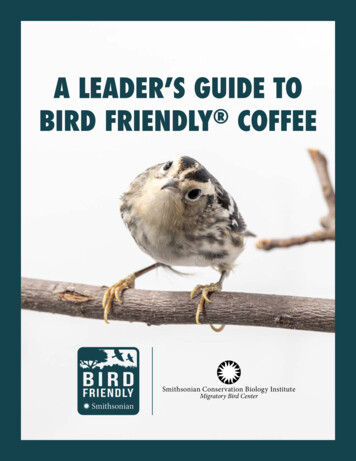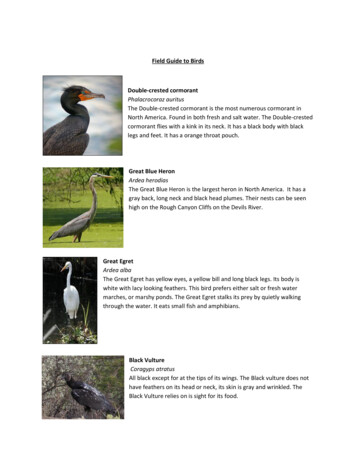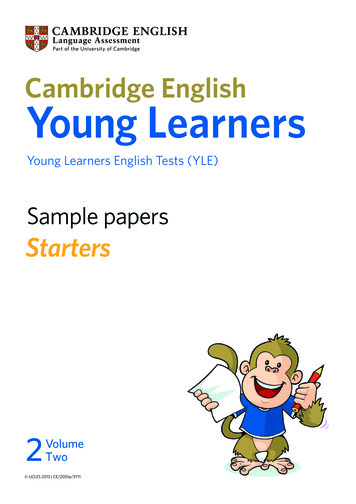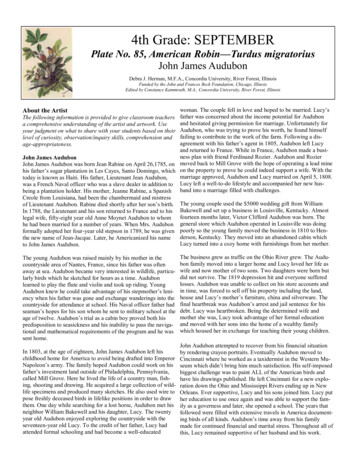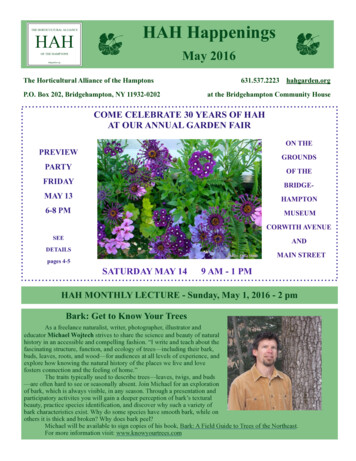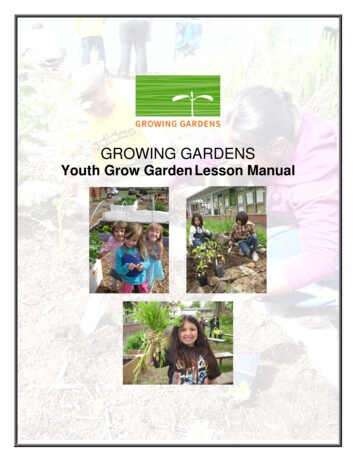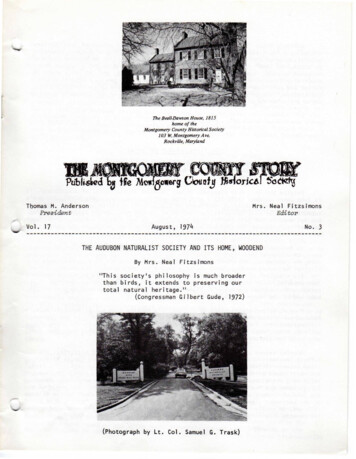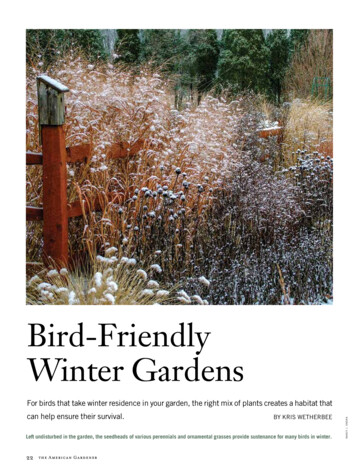
Transcription
Bird-FriendlyWinter Gardenscan help ensure their survival.BY KRIS WETHERBEELeft undisturbed in the garden, the seedheads of various perennials and ornamental grasses provide sustenance for many birds in winter.22the American GardenerNANCY J. ONDRAFor birds that take winter residence in your garden, the right mix of plants creates a habitat that
TOP: JUDYWHITE, GARDENPHOTOS.COM. BOTTOM LEFT: BILL JOHNSON. BOTTOM RIGHT: JANET DAVISWcomes to food andshelter, winter holds noworries for most humans,who can make a quick trip to the supermarket or turn up the thermostat. Butfor backyard birds, winter can be challenging as finding food proves more difficult and shelter becomes scarcer.Shorter days mean less time for birdsto forage. Tasty insects are off the menu inmuch of the country because most hibernate and are well hidden. Many seed-bearingplants have been consumed; others havebeen cleaned up at season’s end or are covered in snow. The selection of fruits andberries has dwindled. What’s more, deciduous trees and shrubs leave little shelter toprotect resident songbirds facing the winterelements and hungry predators.But with a little planning, you can keepwinter birds healthy and happy by creatinga habitat that provides them with a few basic needs—food, water, shelter, and a safeplace to raise a family come spring. Designing a landscape with a multi-layeredcanopy of evergreen and deciduous plantsaccommodates the preferences of differentbirds with everything they need.A bird’s food preferences vary amongspecies, the location, and time of year. Sodo their preferences for shelter and nestingsites. Towhees and juncos, for example,are ground-feeders and nearly always nestbeneath bushes. Nuthatches prefer thesanctuary of trees, where they nest andfeed on tree seeds and insects found onand under bark. And cardinals feed mainly on the ground but nest in the densegrowth of shrubs. (For a list of plantsthat provide for birds in winter, see “BirdFeeders with Roots,” page 26.)HEN ITBERRY BUFFET“Many birds that eat insects during thebreeding season switch to a more omnivorous diet in the wintertime and eat a lotof fruit,” says ornithologist David Bonter, director of citizen science for ProjectFeederWatch at the Cornell Lab of Ornithology in Ithaca, New York. Shrubs andtrees that hang on to their fruit throughwinter are particularly valuable—especially when their berries or fruit are highin fats. Birds must consume a lot of calories derived from fat in winter to helpthem maintain the body temperatureneeded for their survival.In winter, non-migratory insect-eating and seed-eating birds often must supplement theirdiet with berries and fruits from plants such as purple chokeberry (Aronia 5prunifolia), top,and American bittersweet (Celastrus scandens), above left. Above right: A black-cappedchickadee dines on the fruit of a female staghorn sumac (Rhus typhina).November / December 201823
Offer a high-fat buffet that includesberry-laden trees and shrubs such as bayberry (Myrica pensylvanica), sassafras, magnolia, and dogwood (Cornus spp.). Manyplants retain fruits into winter, when coldweather softens and sweetens the fruits sothey are more palatable for birds. Examples include hawthorn (Crataegus spp.),sumac (Rhus spp.), chokeberry (Aroniaspp.), American bittersweet (Celastrusscandens), juniper (Juniperus spp.), Virginia creeper (Parthenocissus quinquefolia),and crabapple (Malus spp.). Some hollies(Ilex spp.) produce berries that can sustainbirds into early spring.SEEDED SPECIALSThe cones of Sitka spruce, above, containwinged seeds. Top right: The seeds of purpleconeflower are favored by many species,including goldfinches. Right: Needle grassis a food source for ground-dwelling birds.You can help ensure a seed feast byallowing spent flowers to remain at season’s end so the seeds can mature. Manyseed-bearing perennials such as coneflowers (Echinacea spp.), tickseed (Coreopsisspp.), penstemons, and sedums (Hylotelephium spp.) are easy to grow and requireminimal maintenance because they aredrought-tolerant once established.24the American GardenerThe seedheads on many grasses are amajor source of food for a variety of birds,particularly in the Southwest, where lotsof grassland species migrate for winter.“This group of birds has experienced agreater decline over the past half centurythan any other group of birds in the U.S.,”says ornithologist Charles van Riper III ofthe University of Arizona in Tucson. Hesuggests allowing grasses such as needlegrass (Nassella spp.) to remain throughwinter to attract and sustain the grasslandbirds that depend on the seeds.Shrubs and trees also feed hungry chickadees, grosbeaks, and other birds. Maples(Acer spp.) have winged seeds; spruces(Picea spp.) are beautifully adorned withcolorful and pendulous seeded cones; red-LEFT: MARK TURNER. TOP RIGHT: JANET DAVIS. BOTTOM RIGHT: LYNNE HARRISONMany of our winter birds, such as chickadees, sparrows, and finches, are seed eaters. And some insect-eaters also rely moreon seeds as winter sets in. An assortmentof perennials and annuals offers a goodsource of the seeds they love.
buds (Cercis spp.) attract many birds withbeanlike pods that persist into winter.GETTING INVOLVED IN BIRD CONSERVATIONSUPPLEMENTING THE FEASTTOP: COURTESY OF ANN FOSTER, FLORIDA, 2016 GBBC. BOTTOM: GRAHAM RICE, GARDENPHOTOS.COMBirds can lose seven to 15 percent of theirbody weight just trying to keep warmon cold winter nights, so well-stockedfeeders are an important supplement toyour garden’s offerings. Look for a birdfeeder that is sturdy enough to withstandwinter weather and also keeps seeds dry.Bear in mind that a variety of seed-filledfeeders placed at different heights willattract more bird species than one feederfeaturing just one type of seed.A wide range of styles is available toaccommodate birds with varying eatinghabits. Tray or platform feeders are designed with an edge around the bottom tokeep seeds from spilling out. They accommodate a wide variety of backyard birds.Place these feeders one to three feet abovethe ground and ground-feeders such asjuncos, towhees, chickadees, and mourning doves will flock to them.Hopper feeders can be hung from atree or mounted on a pole. They comeequipped with hoppers or perches on thesides and are available in many shapes andsizes. These feeders attract the widest variety of seed-eating birds, including grosbeaks, cardinals, and jays.Count the birds in your own backyard and take part in bird conservation worldwide. The Great Backyard Bird Count (GBBC), a joint project of the Cornell Lab ofOrnithology and the National Audubon Society, is an annual four-day event inFebruary that involves people of all levels of birding experience and expertise. Lastyear, an estimated 192,456 participants recorded sighting 6,310 bird speciesand over 28 million individual birds throughout the world. Visit www.birdcount.org to find out how you can participate.Project FeederWatch is a North American study of birds that visit backyardfeeders, nature centers, and other locales. Participants in the winter-long program—operated by the Cornell Lab of Ornithology and Bird Studies Canada—helpscientists track movements of winter bird populations and long term trends in thedistribution and population of birds. Anyone with an interest in birds can participate. Visit www.feederwatch.org for more information.—K.W.Suspended tube feeders—long, cylindrical units with feeding ports and perches—are favored by smaller birds such as finches,siskins, redpolls, and nuthatches. Specialtytube feeders designed with smaller openings can be filled with Nyjer seed—a seedhighly favored by the finch family.Providing supplemental seeds for birdswill not affect their migration habits. “Migration is triggered by changes in photoperiod or day length,” says Bonter. “Youcan offer an amazing smorgasbord of foodin your backyard, but when it comes timefor migrating birds to move on, they will.”UNDER COVERA seed-filled feeder provides a supplementalfood source for birds in a snow-covered garden.Shelter plants range from low-growingshrubs for ground-feeding birds to talltrees for a variety of birds. Although densedeciduous trees, shrubs, and vines providea place where birds can nest or take coverfrom predators or stormy weather, broad-leaf and coniferous evergreens are essentialin the winter garden. The scalelike foliageof junipers and arborvitae (Thuja spp.)and the needles of spruce (Picea spp.),hemlocks (Tsuga spp.), and pines (Pinusspp.) offer birds year-round shelter. Mixing in broadleaf evergreens such as American holly (Ilex opaca), rhododendron,pyracantha, box honeysuckle (Loni ceranitida), and evergreen cotoneaster alsoadds color and texture.If space allows, create a hedgerow ofmixed evergreen and deciduous trees andshrubs such as witch hazel (Hamamelisspp.), holly, mountain ash (Sorbus spp.),trailing blackberry (Rubus spp.), viburnum,and juniper, using three to five of a kind.Many of these plants also bear edible fruit.“The native cholla (Cylindropuntiaspp.), especially when large, serves as a focalpoint for birds in the Southwest,” says vanRiper. He suggests that gardeners retainNovember / December 201825
BIRD FEEDERS WITH ROOTSThese bird-friendly plants and trees serve up a smorgasbord of wintertime seeds and berries favored by birds. Many of theseplants also provide a place where birds can hide from predators or take cover from harsh weather. A new study published inthe Proceedings of the National Academy of Sciences reveals that inclusion of at least 70 percent native plants in gardens iscritical for supporting sustainable populations of insect-eating birds. For some regionally specific plant suggestions, checkout the National Audubon Society web page (www.audubon.org/bird/at home/PlantsCommon.html) and the National WildlifeFederation plant finder SCosmos(Cosmos spp.)Sunflowers(Helianthus spp.)Zinnias(Zinnia spp.)PERENNIALSAsters (Symphyotrichum,Eurybia, Oligoneuron spp.)Coneflowers(Echinacea spp.)Sedums(Hylotelephium spp.)VINES & rginia creeper(Parthenocissusquinquefolia)BIRDS ATTRACTEDCOMMENTSJuncos, finches, sparrows, andbuntingsCardinals, finches, chickadees,titmice, nuthatches, and juncosFinches, chickadees, titmice, andsparrowsSeedheads provide food in late fall and winter; flowersprovide nectar for hummingbirds from summer to fallProlific seed producer; offers a high-fat/high-energyfood sourceNectar-rich blooms attract hummingbirds andcontinue into late fallCardinals, goldfinches, chickadees,nuthatches, and towheesFinches, chickadees, nuthatches,towhees, and other seed-eatersFinches, chickadees, grosbeaks,siskins, and other seed-eatersNectar-rich flowers in late summer and fall, followedby seedheads in fall and winterSummer flowers followed by orange-brown cones thatdarken as seeds mature; seedheads hang on into winterNectar-rich flowers appeal to hummingbirds; uprighttypes, such as ‘Autumn Joy’, offer abundant seedsGround-feeding birds, includingsparrows and towheesEvergreen groundcover with fall berries that persistinto winterWarblers, robins, thrushes, bluebirds,vireos, cardinals, and woodpeckersFall fruits persist into winter; provides seasonal shelterand nesting sitesSHRUBSCotoneastersTowhees, robins, mockingbirds,(Cotoneaster spp.)waxwings, and finchesSprucesGrosbeaks, chickadees,(Picea spp.)woodpeckers, and nuthatchesViburnumsWoodpeckers, mockingbirds,(Viburnum spp.)finches, bluebirds, robins,grosbeaks, and thrushesTREESEastern juniperCedar waxwings, robins, finches,(Juniperusflickers, warblers, grosbeaks, andvirginiana)bluebirdsDogwoodsRobins, bluebirds, vireos, juncos,(Cornus spp.)cardinals, warblers, and towheesHolliesFruit-eating birds, including(Ilex spp.)bluebirds, robins, waxwings,finches, and woodpeckers26the American GardenerEvergreen, semi-evergreen, or deciduous shrubs withlate summer to autumn berries remaining throughwinter; nectar-rich flowers appeal to hummingbirds;provides shelter and nesting sitesEvergreen, coniferous trees and shrubs produceseed-bearing cones and offer year-round shelterand nesting sitesDeciduous and evergreen shrubs provide nestsites and cover; summer and fall fruit sometimespersist into winter, depending on the speciesEvergreen provides shelter and nesting sites; fallfruits persist into winterLate summer to fall berries remain through winter;high-fat berries are an important food source formigrating birdsEvergreen and deciduous trees and shrubs with fallfruits that last into early spring; great for nestingsites and shelter, especially in winter
ResourcesAttracting Birds, Butterflies & OtherWinged Wonders to Your Backyardby Kris Wetherbee. Lark Books,Asheville, North Carolina, 2006.Bird-by-Bird Gardening by Sally Roth.Rodale Press, Emmaus, Pennsylvania, 2009.Bird Studies Canada,www.bsc-eoc.org.Cornell Lab of Ornithology,www.birds.cornell.edu.Gardening for the Birds by GeorgeAdams. Timber Press, Portland, OR,2013.National Audubon Society,www.audubon.org/birds.National Wildlife Federation,www.nwf.org.Project FeederWatch,www.feederwatch.org.Native to North America, eastern hemlock (Tsuga canadensis) has fine-needled evergreenboughs that a wide variety of birds rely on year-round for shelter and nesting.some of these in their landscapes, “as thisplant is a favorite nesting location, providing protection from the many nest predators found throughout the Southwest.”DON’T FORGET WATERTOP: JANET DAVIS. BOTTOM: SUSAN A. ROTHWhen it comes to attracting birds, wateris a powerful magnet. Birds need accessto water year-round, but a dependablefresh water source can be especially hardto find in winter.A heated birdbath is a great way to attract birds to the winter garden. You canalso keep water from freezing in an existing birdbath by adding a submersible,thermostatically-controlled water heaterThe autumn fruits of ‘Scarlett O’Hara’ winterberry (Ilex verticillata) persist through winter.specifically designed for outdoor birdbaths. Birdbaths offer a quick and easyway to provide water at any time of year,but even a shallow waterproof containersuch as a glazed plant saucer or rock witha natural depression will work as long asyou keep it clean and filled.Consider the placement of your birdbaths carefully, cautions van Riper. “Becareful that you do not set up ‘deathtraps’ where the water is neatly hidden inthe vegetation and predators wait in ambush for the birds. Either utilize elevatedwater birdbaths or pans on the ground,but all in the open.”A bird-friendly winter garden needn’tbe large to be effective. You can start witha few trees, shrubs, and perennials, accented with bird feeders, nest boxes, and birdbaths. An area as little as 10 by 10 feet, suchas a large flower bed, a border of mixedshrubs, or even the planted edge of a deckor patio, can help increase the bird population in your yard. Of course, the largerthe habitat, the more birds you’ll attract—and the greater the rewards for all.mKris Wetherbee is a freelance writer livingin Oakland, Oregon. This is an updatedversion of her original article, which waspublished in the November/December 2007issue of this magazine.November / December 201827
For birds that take winter residence in your garden, the right mix of plants creates a habitat that can help ensure their survival. BY KRIS WETHERBEE Bird-Friendly Winter Gardens Left undisturbed in the garden, the seedheads of various perennials and orname
